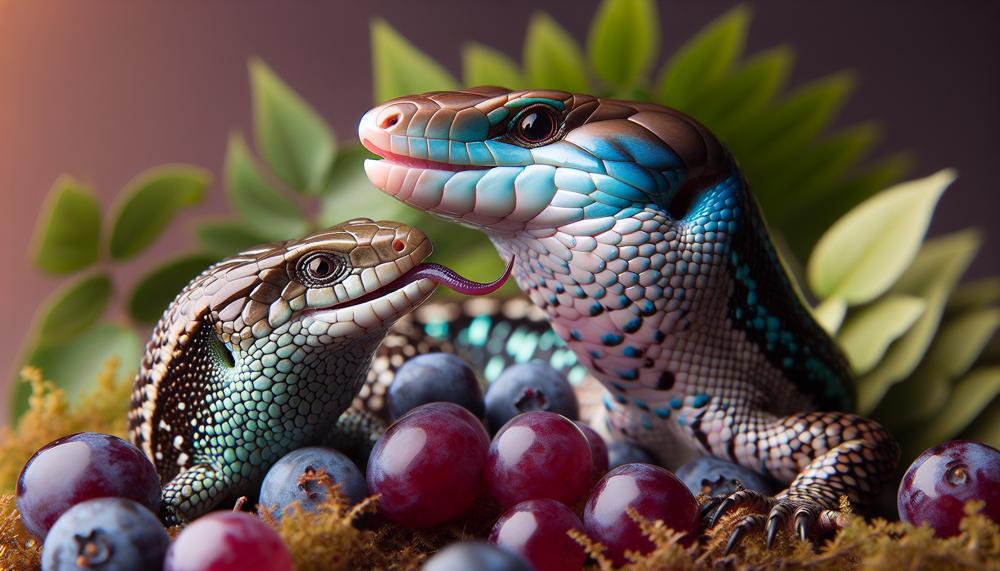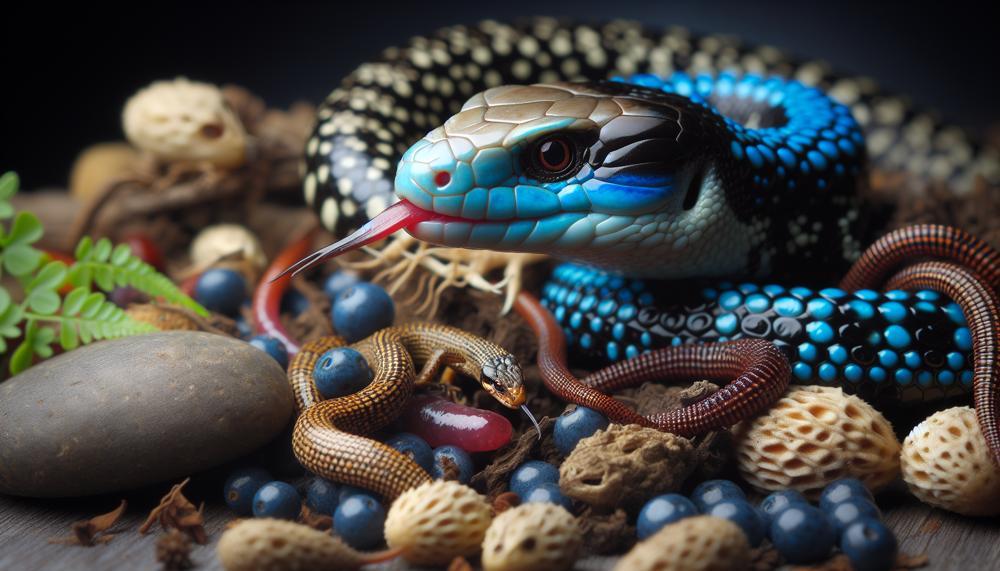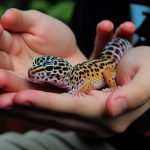Blue tongue skinks are adorable, scaly creatures. They have captured the hearts of many reptile lovers. With their striking blue tongues and gentle demeanor, they have become popular pets in recent years. It’s no wonder! Amidst all the excitement of owning a blue tongue skink, one question often arises: are they poisonous?
The answer is not as simple as a yes or no. While blue tongue skinks do produce a venom, it is not lethal to humans. However, if you’re thinking of cuddling with your skink, think again. The venom can cause pain, swelling, and other unpleasant symptoms if you’re bitten.
But why do these seemingly friendly creatures possess such a toxic defense mechanism? In the wild, blue tongue skinks use their venom to ward off predators and protect themselves. However, this toxicity is more prevalent in wild-caught skinks as captive-bred ones tend to lose their venom over time due to their diet.
As an owner of a blue tongue skink, it’s crucial to handle them with care and respect their natural behaviors. After all, they are still wild animals at heart. In this blog post, we will delve deeper into blue tongue skink toxicity. We will discuss its causes, effects, and how to safely interact with these fascinating creatures.
Whether you already have a blue tongue skink or are considering getting one, keep reading to learn more about their unique characteristics and potential dangers associated with them.
Let’s dive in.
Contents
- 1 Types of Blue-Tongued Skinks
- 2 Geographic Range and Habitat of the Blue-Tongued Skink
- 3 Basic Biology and Natural History of Blue-Tongued Skinks
- 4 Blue Tongue Skink Care: Setting Up and Maintaining the Habitat
- 5 Blue-Tongued Skink Feeding and Diet
- 6 Handling and Interaction
- 7 Basic Biology and Natural History of Blue-Tongued Skinks
- 8 Blue Tongue Skink Care: Setting Up and Maintaining the Habitat
- 9 Blue-Tongued Skink Feeding and Diet
- 10 Handling and Interaction
- 11 Conclusion
Types of Blue-Tongued Skinks
There are 13 officially recognized types of blue-tongued skinks. Each skink has its own distinct traits and characteristics.
These include the common blue tongue skink, Tanimbar blue tongue skink, Northern blue tongue skink, Eastern blue tongue skink, Western blue tongue skink, Central blue tongue skink, Blotched blue tongue skink, and shinglebacks (Western shingleback). There are also Pygmy blue tongue skink (Dwarf), Indonesian (Classic Indonesia), Merauke (Faded), Kei Island (Striking), and Irian Jaya.
These types can be differentiated by their size, appearance, and potential level of toxicity.
Size:
The size of blue-tongued skinks varies significantly among the different types. The common blue tongue skink is the largest of them all. It reaches an impressive average length of 20-24 inches (50-60 cm) and weighs up to 1.5 pounds (700 grams).
In contrast, the Pygmy blue tongue skink is the smallest type, measuring an average length of 8-10 inches (20-25 cm) and weighing only 4-6 ounces (110-170 grams).
Appearance:
All blue-tongued skinks are famous for their striking blue tongues. Each type also has unique physical features that set it apart from the others. The Tanimbar blue tongue skink stands out with its eye-catching orange coloration. The Northern and Eastern types have more reds and yellows in their patterns.
The Western type boasts thick black streaks on the tip of its nose and vibrant orange coloring.
In contrast, the Merauke and Kei Island types have a more subdued appearance, while the Indonesian type is known for its classic coloration. Lastly, the Irian Jaya type has a striking appearance with bold stripes or blotches.
Potential toxicity:
Blue-tongued skinks are not considered to be venomous or toxic to humans.
However, some types may exhibit a more aggressive temperament and use their powerful jaws as a defense mechanism. The Western blue tongue skink, for instance, is known for its more aggressive nature compared to other types.
Additionally, all blue-tongued skinks use their bright blue tongues as a warning signal when feeling threatened by predators.
The 13 recognized types of blue-tongued skinks vary greatly in terms of size, appearance, and potential level of toxicity.
Geographic Range and Habitat of the Blue-Tongued Skink
Blue-tongued skinks are magnificent creatures that primarily inhabit terrestrial environments, thriving on land rather than in water. They are highly adaptable and can flourish in a variety of habitats, including woodlands, grasslands, and even suburban backyards.
These lizards have proven themselves to be resilient and can withstand a wide range of temperatures, from as low as 50 degrees Fahrenheit to as high as 100 degrees Fahrenheit.
In Australia, blue-tongued skinks are commonly found in the eastern and southern regions of the country. They can also be found in some areas of Indonesia and Papua New Guinea. Specifically in Australia, they are most abundant in the states of Queensland, New South Wales, Victoria, and South Australia.
When it comes to specific regions within their habitat, blue-tongued skinks tend to thrive in areas with ample vegetation and hiding spots such as rocks, logs, and leaf litter. They are also known for their burrowing behavior and may create underground dens in their surroundings.
These intelligent lizards have even adapted well to human-altered environments like gardens and parks.
Table Format:
| Terrestrial Habitats | Regions |
| Woodlands | Eastern and Southern Australia, Indonesia, Papua New Guinea |
| Grasslands | Eastern and Southern Australia, Indonesia, Papua New Guinea |
| Suburban Backyards | Eastern and Southern Australia, Indonesia, Papua New Guinea |
| Habitats with Ample Vegetation and Hiding Spots (e.g. rocks, logs, leaf litter) | Regions |
| Woodlands | Eastern and Southern Australia, Indonesia, Papua New Guinea |
| Grasslands | Eastern and Southern Australia, Indonesia, Papua New Guinea |
| Suburban Backyards | Eastern and Southern Australia, Indonesia, Papua New Guinea |
| Underground Dens | Regions |
| Woodlands | Eastern and Southern Australia, Indonesia, Papua New Guinea |
| Grasslands | Eastern and Southern Australia, Indonesia, Papua New Guinea |
| Suburban Backyards | Eastern and Southern Australia, Indonesia, Papua New Guinea |
Basic Biology and Natural History of Blue-Tongued Skinks
Blue-tongued skinks, also known as blue-tongued lizards, are a fascinating and one-of-a-kind species of reptiles. These lizards have distinctive physical features and natural behaviors that make them stand out from other reptiles.
With their stout bodies, strikingly blue tongues, and gentle demeanor, they are easily recognizable. What’s more, their adaptability to different environments and exceptional lifespan make them truly remarkable among other lizard species.
These skinks are native to Australia and come in various subspecies with differing colors and patterns. However, they all share the same physical characteristics that make them stand out.
One of the most notable features of blue-tongued skinks is their wide and stocky body shape, with short legs and a long tail. This makes them efficient diggers and allows them to burrow underground for shelter and protection.
But what truly sets these lizards apart is their vibrant blue tongue, which they use as a defense mechanism against predators. When threatened, they will stick out their tongue to startle and deter potential attackers. This unique trait has also earned them the nickname “blue-tongues.”
Unlike many other reptiles, blue-tongued skinks are not known for their speed or agility. In fact, they are quite slow-moving and docile creatures, making them popular pets. They have a calm temperament and can be easily handled, which makes them suitable for beginner reptile owners.
In addition to their physical characteristics, blue-tongued skinks are also known for their impressive adaptability. They can survive in a wide range of habitats, from deserts to woodlands and even suburban areas. This adaptability has allowed them to thrive in various regions of Australia.
These lizards have a long lifespan compared to other reptiles, with some living up to 20 years or more in captivity. This makes them a long-term commitment for pet owners, but also means they can provide years of companionship and enjoyment.
Blue Tongue Skink Care: Setting Up and Maintaining the Habitat
Creating a safe and naturalistic habitat for your blue tongue skink requires careful consideration and attention to detail. To ensure your pet’s well-being and happiness, follow these steps:
- Select an appropriate-sized tank: Blue tongue skinks need a spacious tank to thrive in their home. It is recommended to have a minimum of 40 gallons for one adult skink, with an additional 20 gallons for each additional skink.
- Choose the right substrate: When it comes to substrate options, aspen, fir bark, and cypress mulch are among the best choices for a blue tongue skink’s habitat. These substrates provide a natural feel and allow for burrowing and digging.
- Set up a natural environment: Layer the tank with logs, branches, and rocks to mimic a blue tongue skink’s natural habitat. This not only adds aesthetic appeal but also provides hiding spots and climbing opportunities for your pet.
- Ensure proper lighting and heating: Blue tongue skinks require both UVB and heating bulbs in their habitat. It is crucial to connect these bulbs to a thermostat to maintain the right temperature for your skink.
- Monitor the temperature: Regularly check the temperature in your skink’s habitat using thermometers. The recommended range is 85-90°F on the warm side and 75-80°F on the cool side.
- Add hides and accessories: As shy creatures, blue tongue skinks need hiding spots in their habitat. You can use terracotta pots, cork bark, or commercial hides for this purpose. Additionally, you can add rocks, plants, and other decorations sparingly to provide enrichment for your pet.
- Keep it clean: Maintaining cleanliness is crucial in preventing bacteria build-up and ensuring a healthy environment for your pet. Promptly remove any uneaten food or fecal matter.
- Monitor humidity levels: Blue tongue skinks require moderate humidity levels of 40-60%. Use a hygrometer to monitor humidity levels and make adjustments as needed.
- Provide a balanced diet: A varied diet of vegetables, fruits, and insects is essential for the health and well-being of your blue tongue skink. Be sure to provide supplements as needed.
Blue-Tongued Skink Feeding and Diet
A well-balanced diet is crucial for the proper nutrition and health of blue tongue skinks. Fruits, vegetables, insects, meat, and calcium powder should all be included in their diet to ensure they receive the necessary nutrients. However, it’s important to note that fruits should only make up a small portion of their diet (10%) and should not include citrus fruits, pits/seeds, avocado, or rhubarb.
The majority of a blue tongue skink’s diet should consist of vegetables, making up 40-50% for adults and 20-30% for babies. Some vegetables may need to be mashed or combined with other foods to encourage consumption. Meat can also be included as a protein source but should not replace feeder insects. Feeder insects are essential for exercise and enrichment for blue tongue skinks and should be gut-loaded before feeding.
It’s also important to note that captive blue tongue skinks may develop a preference for insects due to being fed extra protein for sale purposes. Thus, it’s crucial to monitor their diet and ensure they receive a balanced mix of all food groups.
To prevent boredom and provide variety in their diet, it’s important to mix up their food regularly. This can include different types of leafy greens, vegetables, fruits, insects, and meat sources.
Additionally, feeding schedules should be adjusted based on the skink’s age. Adult skinks (over 8 months) can be fed 1-2 times a week, sub-adults (3-8 months) every 2-5 days, and babies (0-3 months) daily.
When selecting fruits and vegetables for a blue tongue skink’s diet, certain foods should be avoided as they can be harmful. As mentioned before, citrus fruits, pits/seeds, avocado, and rhubarb can cause digestive issues and even be toxic to blue tongue skinks.
Handling and Interaction
When it comes to handling and interacting with blue tongue skinks, it is essential to pay attention to the details in order to ensure the safety of both the skink and the handler. Socialization and bonding are important for these reptiles, but it is crucial to handle them correctly.
The first step in handling a blue tongue skink is to approach them slowly and with a sense of calmness. This will prevent the skink from feeling scared or getting defensive. Additionally, it is crucial to support the entire body of the skink, including its tail, while handling them. This will help avoid any injuries or discomfort for the skink.
In order to tame a blue tongue skink and prevent them from becoming hostile or bored, regular handling sessions are recommended. These sessions should include taking the skink to different areas of the house to get them accustomed to different environments. This will also provide mental stimulation for these intelligent creatures.
If you are dealing with a new skink, it is important to give them some time to adjust before starting handling sessions. It is recommended to wait 2-3 weeks (or 4 weeks for wild caught) before beginning handling. This will give the skink time to become comfortable with its new environment and owner.
It is also important to teach others how to handle a blue tongue skink correctly in order to prevent any injuries or stress for both the handler and the reptile. Remember to support their whole body, including their tail, while holding them. If the skink happens to pee or poop while being handled, it is important to stay calm and wash your hands as well as change your clothes before continuing handling.
To build trust with your skink, consider offering treats before handling sessions. Additionally, using gloves can provide added protection against bites. While some species may be more aggressive than others, patience and proper handling techniques can help tame all blue tongue skinks.
Basic Biology and Natural History of Blue-Tongued Skinks
Blue-tongued skinks are a captivating and distinctive lizard species with unique physical attributes that contribute to their survival in the wild. These characteristics include their robust jaws, striking blue tongues, stout bodies, diverse diet, and ability to form monogamous partnerships.
The formidable jaws of blue-tongued skinks allow them to effectively ambush prey, making them skilled hunters in their natural habitat. Their bright blue tongue serves as a warning sign to potential predators and also plays a role in communication with other skinks. This allows them to evade danger and maintain social connections within their community.
Although their stocky bodies may make them less agile, it also makes them less vulnerable to predators. This is especially beneficial in open habitats where they may be easily spotted by predators. Moreover, the stocky body structure of blue-tongued skinks enables them to dig deep burrows for shelter, providing protection from harsh weather conditions and potential predators.
Blue-tongued skinks have a varied diet that includes insects, gastropods, flowers, fruits, and berries. This diverse diet allows them to adapt to different environments and ensures a steady food supply, increasing their chances of survival.
In terms of reproduction, blue-tongued skinks form monogamous partnerships for a short period each year. This helps to maintain genetic diversity and prevent inbreeding, promoting the overall health of the species.
Overall, the physical characteristics of blue-tongued skinks play a vital role in their survival in the wild.
Blue Tongue Skink Care: Setting Up and Maintaining the Habitat
To ensure proper care for blue tongue skinks, it is crucial to create a habitat that closely resembles their natural environment. This includes providing ample space for growth and movement, maintaining suitable temperature and humidity levels, and incorporating hiding spots and decorations for both stimulation and safety. A well-suited habitat for blue tongue skinks should consist of the following components:
- Enclosure: A spacious enclosure is necessary to allow blue tongue skinks to grow and roam freely. The Carolina Custom Cages Terrarium is a recommended choice for its simple assembly and water-resistant base.
- Materials: Wood, glass, and PVC are three suitable materials for preserving high humidity levels. These materials also provide insulation, preventing heat from escaping.
- UVB Light: UVB light is essential for blue tongue skinks to produce vitamin D3 and prevent metabolic bone disease. A UVB light bulb, such as the Zoo Med ReptiSun 10.0 UVB Bulb, should be placed in the enclosure.
- Temperature: Basking temperatures should range between 85 to 95ºF (30 to 35ºC), while the cooler side should be maintained at 70 to 80ºF (21 to 27ºC). For accurate temperature monitoring, a digital thermometer like the Zoo Med Digital Thermometer is recommended.
- Substrate: Skinks are burrowing reptiles, so selecting the right substrate is crucial. Popular options include coco husk, moss, and sphagnum moss, which also help maintain humidity levels. Sand, pine or cedar bark/chips should be avoided.
- Hides: Hides are vital for burrowing behavior. It is recommended to have two hides (one on each side) to provide a sense of security. The Zilla Reptile Habitat Décor Shale Rock Den offers a hiding spot and basking platform in one.
- Decorations: Branches, logs, and rocks provide stimulation and mimic natural habitat. The Zilla Reptile Habitat Décor Hideouts Bark Bends is a safe option for climbing. Real or fake plants can also be added, but they should be durable and non-toxic to skinks.
- Backgrounds: Backgrounds can enhance the overall design of the enclosure and offer a sense of security for skinks. The BNS Reptile Habitat Background is resistant to scratches and water damage.
When placing decorations, it is important to consider the safety of blue tongue skinks as they are not skilled climbers. Ensure that rocks are stable and avoid any sharp edges or decorations that may cause harm.
Blue-Tongued Skink Feeding and Diet
Blue-tongued skinks are omnivorous reptiles, meaning they require a diverse diet consisting of a range of fruits, vegetables, and insects. To maintain their health and vitality, it is important to follow a consistent feeding schedule and provide a well-rounded diet that includes all essential nutrients.
Feeding Schedule:
- Adult skinks can be fed 1-2 times a week, with each meal consisting of 1-2 tablespoons of food.
- Sub-adults should be fed every 2-5 days.
- Babies should be fed daily until they reach 2 months old, then every 2 days.
Diet Breakdown:
- Vegetables should make up 40-50% of an adult skink’s diet and 20-30% of a baby’s diet.
- While fruits can be given occasionally or as treats, they should not make up a significant portion of their diet.
- Meat can also be included in their diet but should not replace feeder insects.
- It is not recommended to feed them dog food as it lacks proper nutrients.
Insects:
Feeder insects are preferred as they provide exercise and mental stimulation for the skinks.
However, wild caught insects, lightning bugs, and scorpions should never be fed to them.
Calcium:
Calcium is crucial for their bone growth and should be included in their meals.
For adults, calcium powder with Vitamin D3 should be given once a week, while sub-adults and babies without access to UVB lighting should receive it twice a week.
Variety is Key:
A balanced diet of leafy greens, vegetables, insects, meat, and occasional fruits is necessary for healthy growth. It is important to offer a variety of food options to ensure they receive all necessary nutrients. Additionally, breaking the food into smaller pieces can prevent picky eating.
Conclusion:
In summary, the ideal diet for blue-tongued skinks includes a diverse range of fruits, vegetables, insects, and occasional meat.
It is essential to follow a consistent feeding schedule based on age and offer a balanced and varied diet to maintain their health and well-being.
Handling and Interaction
When interacting with blue tongue skinks, it is vital to take necessary measures to prevent any harm from their mild toxin. This includes avoiding direct contact with their saliva and bodily fluids, wearing protective gloves, and being mindful of any potential allergies.
Furthermore, it is crucial to handle them with care and wash your hands thoroughly after handling.
Handling and Interaction:
Blue tongue skinks are fascinating creatures with unique personalities, but they also possess a mild toxin that can be harmful if not handled properly. To ensure a safe and enjoyable interaction with these reptiles, there are some precautions you should take.
Firstly, it is important to avoid any direct contact with their saliva or bodily fluids. While the toxin is generally harmless to humans, it can cause irritation or allergic reactions in some individuals. To prevent this, it is best to wear gloves when handling blue tongue skinks and to avoid any contact with their secretions.
In addition, it is crucial to handle these skinks gently and with care. They are delicate creatures that can easily become stressed if mishandled. This can lead to potential health issues and even result in the skink biting as a form of defense. So, when handling them, always be gentle and avoid sudden movements.
After interacting with blue tongue skinks, it is essential to wash your hands thoroughly. This will not only remove any potential toxins from their skin but also prevent the spread of bacteria or other harmful substances.
Conclusion
In conclusion, blue tongue skinks are truly remarkable creatures. They have their own distinct characteristics and behaviors. This makes them a popular choice for pet owners.
Despite having a venom, it poses no threat to humans. However, it is crucial to handle these reptiles with caution. Acknowledge their wild nature.
There are 13 recognized species of blue-tongued skinks. They vary in size, appearance, and potential toxicity. It’s essential to understand their specific needs and natural habitats. Providing a safe and naturalistic environment for your pet is vital. It ensures their overall well-being and happiness.
A balanced diet is crucial for their nutrition. It consists of vegetables, fruits, insects, meat, and calcium powder. When interacting with these intelligent creatures, it’s important to approach them slowly. Support their entire body to prevent any harm or discomfort.







